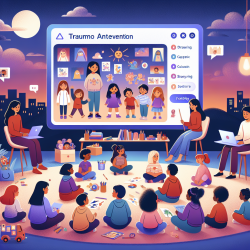Background and Significance
Video-telehealth delivery of trauma-based care has shown promise in overcoming structural and perceptual barriers, such as geographic locality and social stigma, by providing access to interventions at home. The research primarily focuses on adult populations, leaving a gap in evidence for children and adolescents. The study by Pérez-Aronsson et al. addresses this gap by adapting the Teaching Recovery Techniques (TRT) for online delivery and investigating its usability.
Key Findings
- Safety: The study emphasizes the need for robust safety protocols, including emergency response procedures and clear communication strategies. These are crucial for ensuring the well-being of participants during online sessions.
- Participation: Facilitators must foster a sense of group cohesion and active participation. The research highlights the importance of adapting group sizes and session lengths to maintain engagement and interaction.
- Learning: The study underscores the need for detailed guidance on using online tools effectively. Facilitators should be trained to handle technical issues and ensure that participants can easily access and use digital resources.
Practical Recommendations
Based on the study's findings, practitioners can implement several strategies to enhance the effectiveness of online trauma interventions:
- Develop Comprehensive Safety Protocols: Include clear guidelines on handling emergencies and maintaining participant safety during online sessions.
- Foster Group Cohesion: Use ice-breaker activities and encourage small talk to build a sense of community among participants.
- Enhance Digital Literacy: Provide training for both facilitators and participants on using video-conferencing tools and digital resources effectively.
- Adapt Session Formats: Consider reducing group sizes and session lengths to maintain engagement and ensure that participants can comfortably participate from their environments.
Encouraging Further Research
The study highlights the importance of participatory design in adapting interventions. Practitioners are encouraged to involve stakeholders, including children, parents, and professionals, in the design and evaluation process. This approach ensures that the interventions are user-friendly and meet the needs of all participants.
To read the original research paper, please follow this link: Adaptation of the trauma group intervention ‘Teaching Recovery Techniques’ for online delivery: A participatory design and usability study.










